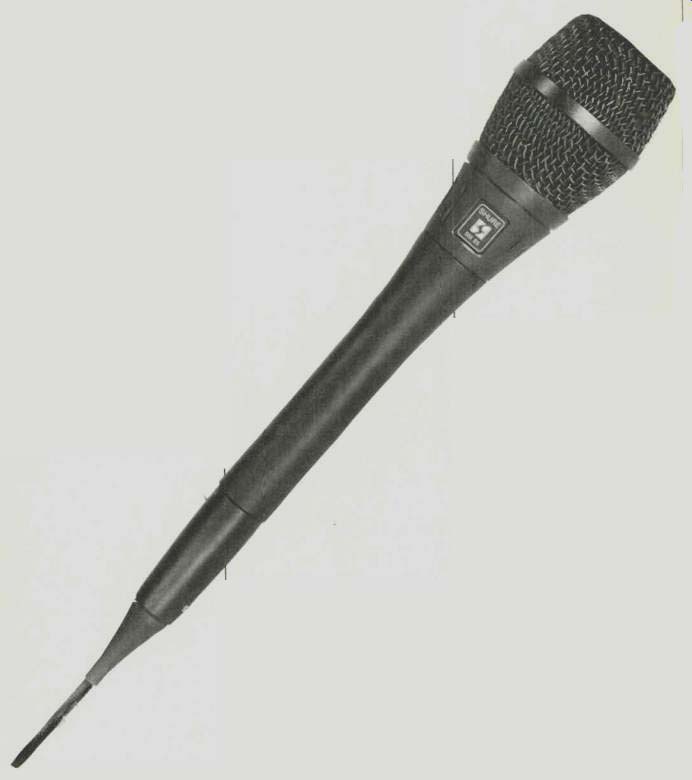
Manufacturer's Specifications:
Type: Cardioid condenser, electret bias.
Frequency Response: 50 Hz to 15 kHz.
Polar Pattern: Cardioid (unidirectional).
Output Impedance: Rated, 150 ohms; actual, 85 ohms.
Output Level at 1 kHz: Open-circuit voltage, 74 dB re 1 V/microbar (54 dB V/Pa).
Clipping Level at 1 kHz: 800-ohm load, -4 dBV (0.63 V); 150-ohm load, -15 dBV (0.18 V).
Maximum SPL: 800-ohm load, 142 dB; 150-ohm load, 134 dB.
Hum Pickup: -7.5 dB equivalent SPL in a 1-millioersted field, 60 Hz.
Output Noise (Equivalent SPL): 29 dB typical, A weighted.
Dynamic Range: 113 dB, maximum SPL to A-weighted noise level.
S/N Ratio: 65 dB at 94 dB SPL, per IEC 179.
Power: 11 to 52 V d.c. at 1 to 1.2 mA current.
Connector: Three-pin professional audio (Switchcraft A3M).
Case: Black vinyl-finished aluminum handle with black Teflon-coated steel mesh grille.
Dimensions:
Overall length, 7-9/16 in. (192 mm); head diameter, 1-15/16 in. (48.8 mm); handle, 25/32 in. (20.1 mm). Weight: 6.3 ounces (180 grams).
Cable: 25 ft. (7.6 m), two-conductor shielded with A3M and A3F type connectors (cable and mike connectors are black).
Supplied Accessories: Windscreen, 49A57; swivel adaptor, A57E; cable (Model SM85-CN only), C97CN.
Available Accessories: PS1 and PS1E2 a.c. power supplies for two SM85 mikes; PS1 is 90 to 132 V a.c., 50/60 Hz; PS1-E2 is 90 to 132/180 to 250 V a.c, 50/60 Hz.
Prices: SM85 mike (less cable), $231.00; SM85-CN mike (with cable), $252.00; PS1 power supply, $135.00; PS1-E2 power supply, $164.00.
The Model SM85, the second professional-grade electret condenser microphone manufactured by Shure, is intended primarily for hand-held vocal applications. It features highly durable construction plus a "space-frame" shock mount that is said to offer resistance to handling noise and mike stand vibration by performers. Audiophile applications would appear to be geared to voice recording and musical instrument reinforcement, but the published data hint that the SM85 may be useful in more diverse applications such as choral pickup and accent of musical instruments (i.e., brass and woodwinds) plus sound system applications where vocal clarity, feedback immunity, and people-proof reliability are desired.
The all-black finish is a radical departure for the conservative Shure firm, but it is a logical choice considering that the musical amplifiers and speakers often used by "pop" groups are also finished in black. (This harkens back to the days before TV when mikes were finished in black-and chrome combinations and were intended to be visible.) The SM85 handle and grille are all metal, and the plastic finishes seem to be extremely durable. However, compared to the SM81 (see Audio, August 1980) which has a vinyl metallic nickel paint finish, the SM85 gave the impression of a plastic microphone. This impression is strengthened by the indents in the transition piece between the handle and the head, which give the appearance of a molded plastic part.
Powering is by an external supply via the familiar phantom system which Shure calls "simplex." In this scheme, ordinary two- or three-wire shielded microphone cable is used, with both audio lines carrying positive d.c. power and the negative power carried by the shield or ground conductor. Phantom powering is basically a balanced-circuit concept and is somewhat tricky to adapt to unbalanced inputs which are prevalent in audiophile tape recorders. Some mixers and sound reinforcement amplifiers used by audiophiles may have balanced inputs but may not have a provision for d.c. powering of microphones. The "Measurements" section of this report, in addition to test results and studies on powering, will offer suggestions for audiophile use of the SM85.
The electronics in this mike are generally similar to those in the SM81. The block diagrams for the two microphones are identical, except that the SM85 does not include a capacitative capsule attenuator. The SM85, being "performer-proof," has no operable switches, so the high-input SPL rating must be achieved by reduction of capsule sensitivity and/or reduced amplifier gain. Since total dynamic range can only be stretched so far, the noise level (equivalent SPL) of the SM85 is 29 dBA compared to 16 dBA for the SM81. Total dynamic range (maximum SPL minus noise SPL) is rated at 113 dB for the SM85 as against 119 dB for the SM81. (My calculation based on Shure specifications for the SM81.) As a reference, dynamic range of 110 dB should be considered excellent for a professional-grade microphone preamplifier.
Cable is not included with the SM85. If the user wants a matching black cable with a black-finished connector, Model SM85-CN must be ordered. Otherwise, any microphone extension cable having three-pin connectors (Switchcraft A3M, A3F, or similar) may be used with the SM85.
Power-Supply Considerations
Every time I have reviewed externally powered condenser microphones, including the air condenser and electret varieties, I have used the a.c. power supplies furnished by the manufacturers. Each one, I have found, is designed differently, so that each series of tests begins with a study of powering. My principal concern here is for the audiophile who will want to connect the SM85 to an unbalanced low impedance input found on many tape recorders. Phantom (simplex) powering, as mentioned above, is basically designed for use with balanced circuits. When the output of a condenser microphone and power supply is connected to an unbalanced input (one audio line grounded), there may be a loss of level, hum or noise or, in the worst case, sparks and smoke! The latter problem is less frequent these days since manufacturers incorporate coupling capacitors that block the d.c. from appearing on the output pins; the Shure power supplies have these capacitors.
Electret microphones with internal batteries do not react badly to unbalancing the output because they have integral transformers, and the audio output is from a secondary winding which is isolated from ground. When I've had problems in the past with external power supplies, I've introduced an audio line transformer between the supply and the test gear. This allowed connecting the microphone audio to balanced or unbalanced circuits and avoided the attendant problems.
In general, most, if not all, power supplies having output transformers may be connected to unbalanced or balanced inputs with impunity. However, the "active" or transformer less supplies may be connected to balanced inputs, but not to unbalanced inputs unless recommended by the manufacturer. The PS1-E2 power supply used for testing is an "active" type, but Shure indicates that the audio output may be unbalanced. The concern with unbalancing an active supply is that a short-circuit on one-half of the audio could cause distortion. This is why the manufacturer should be consulted before proceeding to unbalance the output.
Measurements
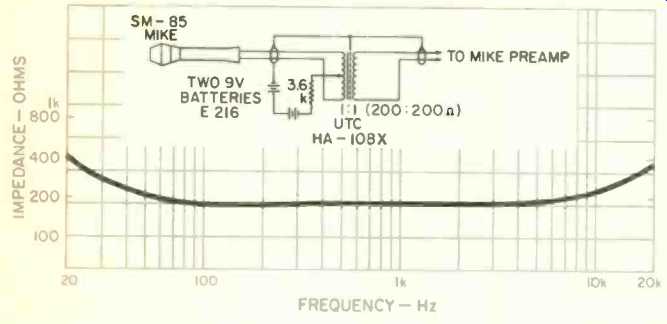
Fig. 1--Impedance vs. frequency, Shure SM85 microphone, with schematic of
battery/ transformer power supply (unbalanced test circuit).
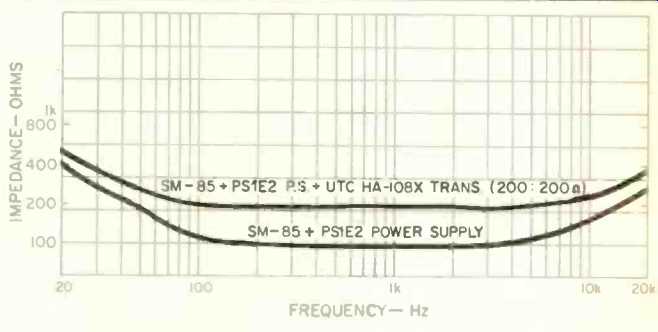
Fig. 2--Impedance vs. frequency with Shure power supplies (unbalanced test
circuit).
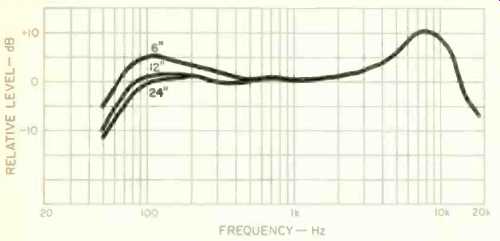
Fig. 3-Frequency response vs. distance to source.
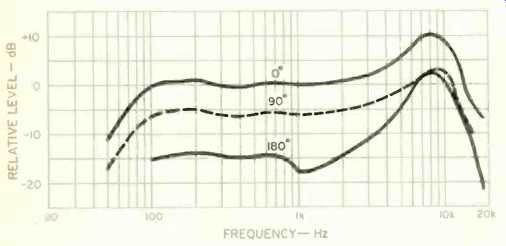
Fig. 4--Frequency response vs. angle.
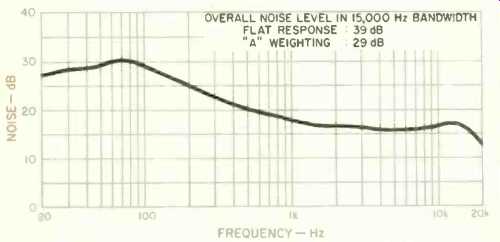
Fig. 5--One-third octave band spectrum of noise from SM85 microphone with
Shure PS1-E2 power supply.
When I began testing the SM85, I lacked the PS1 or PS1E2 power supply, so I rigged a battery-transformer supply as described in the Shure instructions. The schematic of this supply and the resulting impedance curve are shown in Fig. 1. The transformer is an expensive, well-shielded unit but is not highly copper-efficient, and it adds about 80 ohms to the midrange impedance due to winding resistance. The rise in impedance at low and high frequencies is a characteristic of the SM85 (Fig. 2). The impedance (with the Shure PS1-E2 power supply, output unbalanced) is below 100 ohms as per specifications at 1 kHz. When the transformer is added, the midrange impedance increases by 80 ohms, as above. Thus, the impedance test reveals no problems with unbalancing the output of the Shure PS1-E2.
The axial frequency response versus distance to source shows a flat and very smooth response at 12 to 14 inches from 80 Hz to 2 kHz. At six inches, some bass boost from proximity effect is seen; if the performer "swallows" the mike, the bass boost will be considerable. Presumably, the increased "warmth" or "boominess" will be welcomed by the performer, for otherwise, a bass roll-off equalizer will be required at the mixer. The response rises smoothly from 2 kHz to a rounded peak of + 10 dB at 8 kHz. This, presumably, is responsible for the "sizzling highs" mentioned in the Shure catalog sheet and which are desired in contemporary "pop" music.
The frequency response curves (Fig. 4), taken at different angles of incidence, show the well-controlled cardioid pattern I have come to expect in Shure microphones. The 90° rejection is 6 dB, as in an ideal cardioid throughout the useful frequency range. The 180° rejection approximates 15 dB up to 2 kHz. Above this frequency, the rejection is less, probably because of unavoidable diffraction effects, and, of course, room noise and feedback are much less of a problem at this high a frequency.
The noise spectrum (Fig. 5) shows "a smoothly falling characteristic and an overall level of 29 dBA equivalent input SPL, which meets the Shure specifications. For this test, I used the Shure power supply in the balanced mode.
The frequency response curves were measured with both balanced and unbalanced inputs using my transformer supply and Shure's power supply. There was no change in frequency response, just small changes in overall output levels. With a balanced input, sensitivity was-54 dBV/Pa with the transformer supply and-53 dBV/Pa with the Shure supply. With an unbalanced input, the sensitivity with the Shure supply was-55 dBV/Pa, but the transformer supply showed no change in sensitivity.
The clipping level (with transformer supply unbalanced) was ±0.4 V (peaks viewed on scope). This is -8 dBV (peak) or-11 dBV (rms), which translates to an input SPL of 137 dB. This value is in between the two values Shure specifies with different loads, and I think it is quite sufficient for the loudest rock vocalist with "mike-in-mouth." The total dynamic range I measured, therefore, is 137 dB minus 29 dB, or 108 dB. This is lower than the specification value, but since the latter is noted as a "maximum," the measured number is not contrary to spec. A dynamic range of 108 dB is quite acceptable for the intended applications.
Use and Listening Tests
As in previous reviews, the reference microphone for subjective comparison tests was a Nakamichi CM-700 with a cardioid capsule. This reference microphone was chosen because of its uniform frequency response and directivity, and not because it is a better mike for the application than the unit being reviewed. For this test, I did not have the opportunity to compare the two microphones with live music as a source; I used master tapes of live concerts played back over studio monitor speakers. To add some low-frequency noise to the room, I turned on an air conditioner.
The Shure, as compared to the Nakamichi (flat response), exhibited greater rejection of room noise, while showing greatly increased high-frequency sound with distant voice or music sources. In a quiet room, the self-noise of the SM85 could be heard as "hiss." (Presumably, the Shure will not be used for pickup of very low-level sounds.) With close-up speech at six inches, and the Nakamichi on "Lo-Cut," the SM85 picked up more room noise, but the voice sound had much more punch due to warm bass plus very crisp highs.
The magnetic hum pickup of the SM85 as compared to the reference mike on flat response was virtually nonexistent (20 dB less?). Thus, the SM85 can be used near high-powered musical instrument amplifiers with little problem.
Without the supplied accessory foam windscreen, the SM85 was slightly more sensitive than the reference mike to "pop" or breath-blast sound when each was held very close to the mouth. For this test, the Nakamichi was on "Lo-Cut" and used with its accessory screen. The slight difference seemed to be related to the greater bass response of the SM85 under these conditions, which caused a low-frequency thump sound. With the foam screen in place, the Shure was essentially free of pop noise, like the reference. I would recommend using the foam screen whenever the SM85 is used at very close distance. Popping should not be a problem without the foam screen if the performer uses professional microphone techniques.
The vibration and handling noise sensitivity of the Shure mike was about the same as the reference with the latter set for "flat" or "Lo-Cut" response. This indicates that the internal shock mounting of the SM85 is effective.
The Shure SM85 performs as advertised, and measured data values meet or exceed specifications. I can highly recommend it as a vocal microphone. Since the frequency response extends more than an octave above and below the voice range, the SM85 is certain to be used for music pickup where it will enhance the sound of the treble instruments. Obviously, it is not the best mike for recording a symphony orchestra, but it may be of value in adding clarity to choral recordings and for accenting individual instruments.
The SM85 may be connected to unbalanced inputs of tape recorders via the Shure power supplies or a homemade transformer supply. By referring to the detailed instructions in the Shure data sheet, the audiophile may be able to devise other powering schemes to suit his or her particular recorder or mixer.
I highly recommend the SM85 to "pop" music recording enthusiasts, and hope that classical recordists will try it as suggested.
-Jon R. Sank
(Source: Audio magazine, May 1982)
Also see:
Shure SM-81 Unidirectional Condenser Microphone (Aug. 1980)
Shure Model 516EQ Microphone (Apr. 1977)
Shure SM91 Microphone (Equip. Profile, Jun. 1986)
Shure SM89 Shotgun Condenser Mike (Dec. 1990)
Sennheiser MKH 40 Microphone (Equip. Profile, Jan. 1988)
= = = =